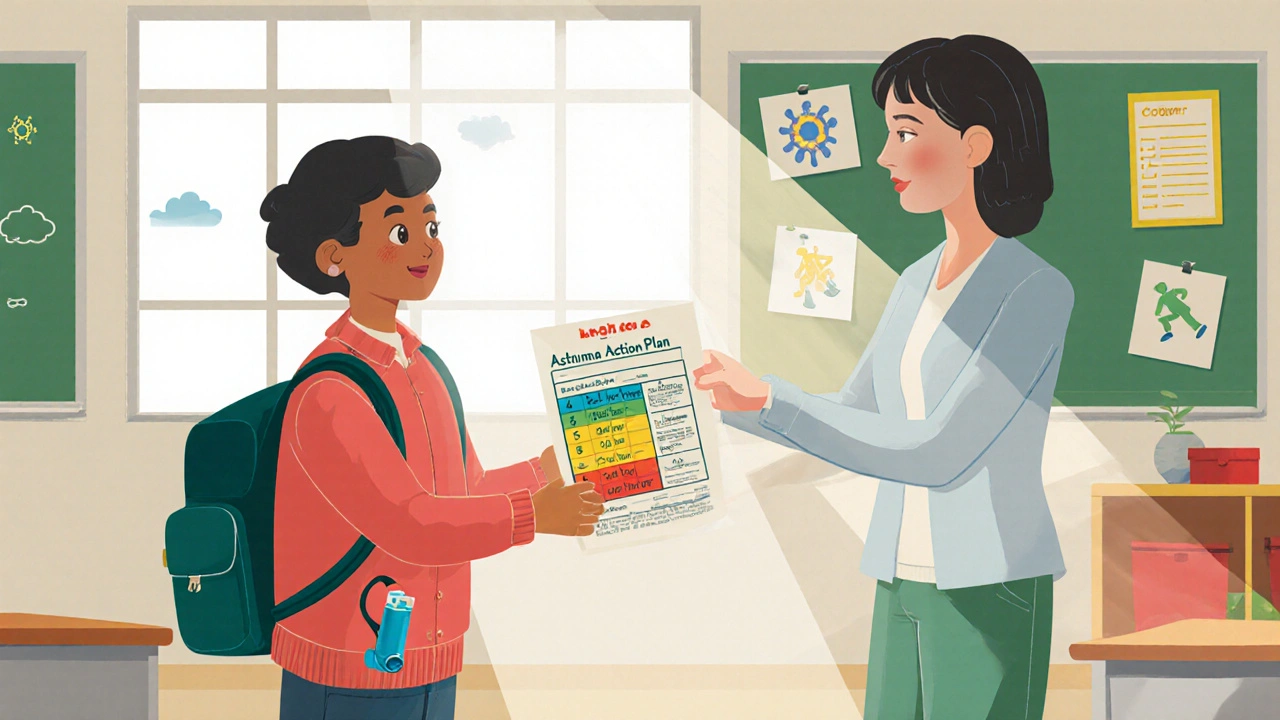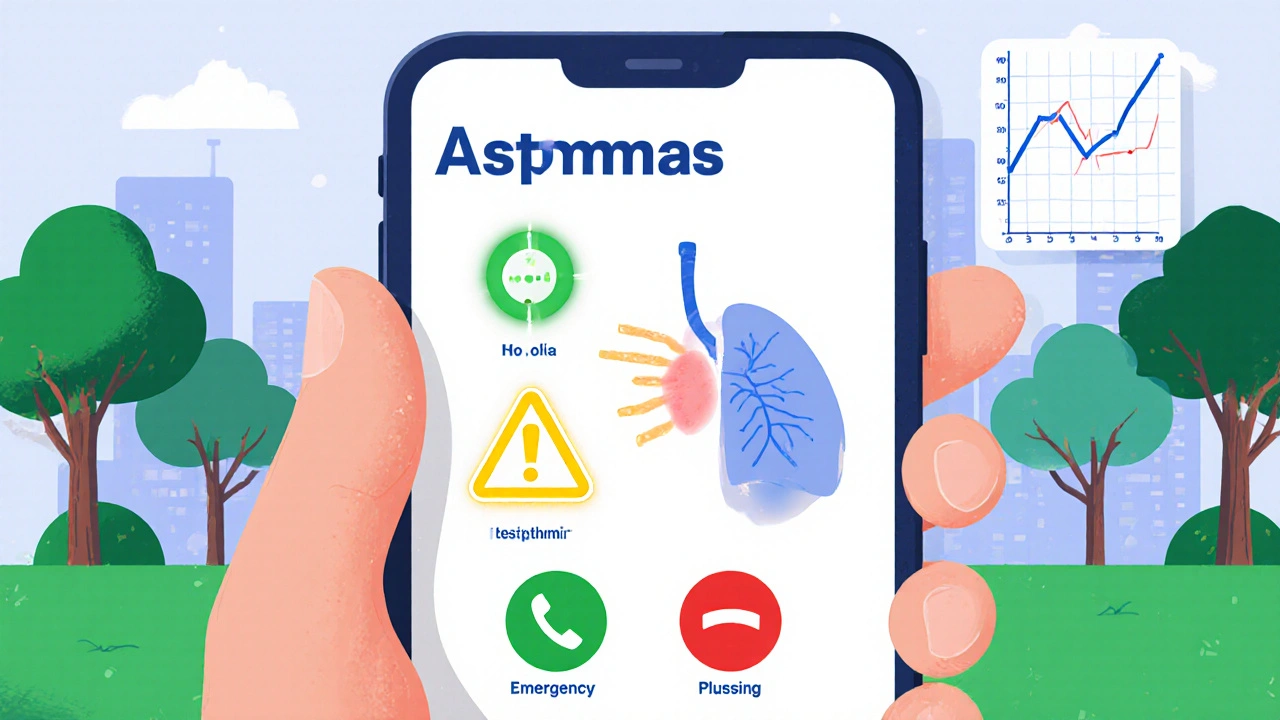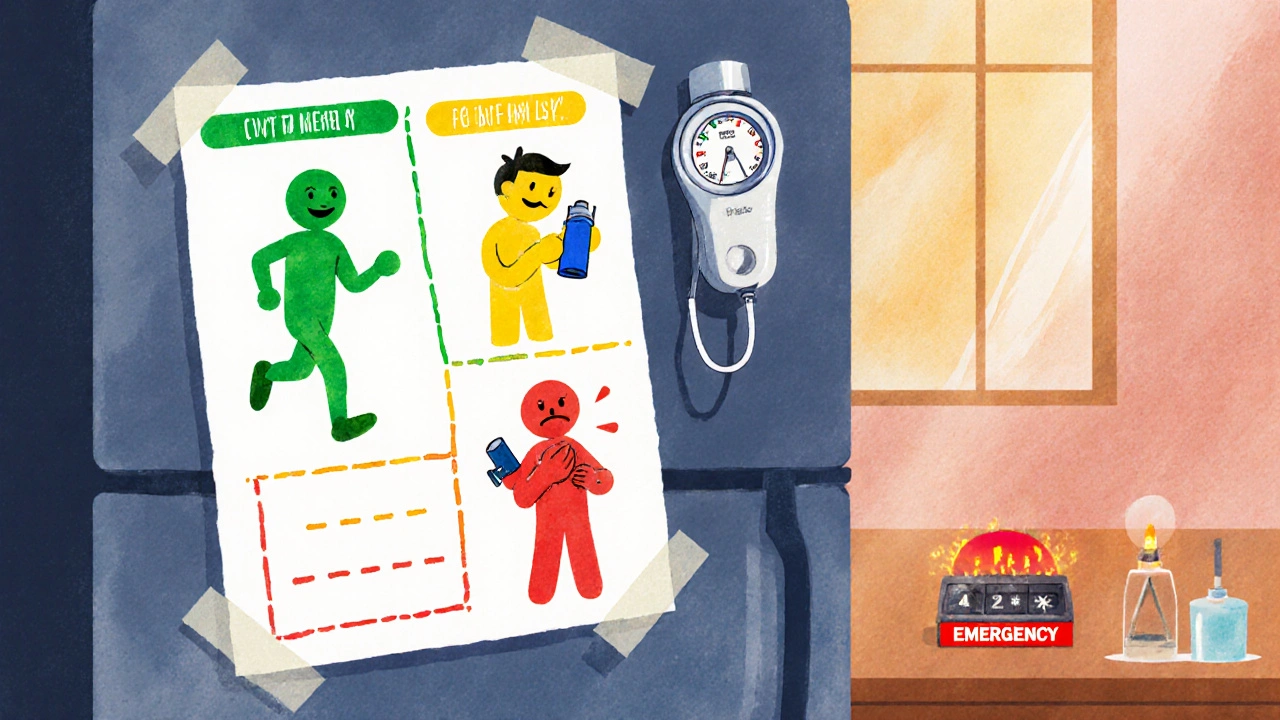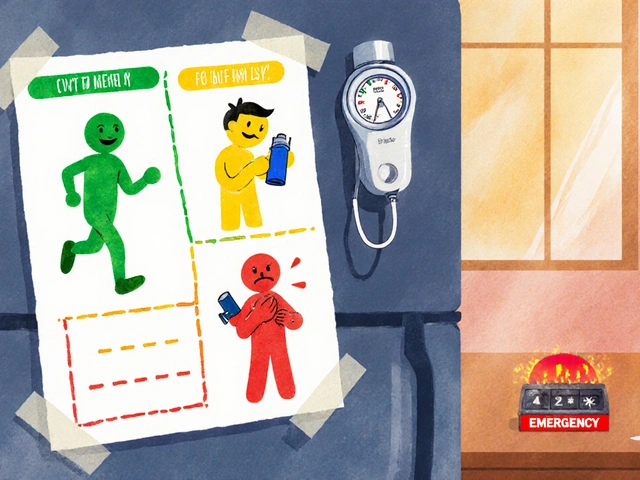If you or someone you care about has asthma, you’ve probably heard of an asthma action plan. But do you actually use one? Or is it tucked away in a drawer, forgotten until a cough turns into a panic attack? You’re not alone. Only 30% of people with asthma have a written plan, even though research shows those who do cut their emergency room visits by up to 70%. This isn’t about fear. It’s about control. And it starts with a simple, personalized guide that tells you exactly what to do - before things get dangerous.
What Exactly Is an Asthma Action Plan?
An asthma action plan is a written, color-coded roadmap for your asthma. It’s not a suggestion. It’s a medical tool, created with your doctor, that breaks down your daily asthma management into three clear zones: green, yellow, and red. Think of it like a traffic light. Green means go - you’re in control. Yellow means slow down - your asthma is worsening. Red means stop - you need help right now. This system was developed by the National Heart, Lung, and Blood Institute (NHLBI) and is used by 92% of U.S. healthcare providers. It’s simple, visual, and works even when you’re stressed or struggling to breathe. Studies show people who use color-coded plans stick to their meds 68% of the time - compared to just 42% with text-only instructions. The plan includes your personal best peak flow number (more on that later), which medications to take daily, when to increase them, and when to call 999 or go to A&E. It’s not a one-time document. It changes with your life - your allergies, your activity level, even the season.The Three Zones: Green, Yellow, Red
Every asthma action plan follows the same three-zone structure. Here’s what each one means in real terms.- Green Zone (Go): You feel fine. No coughing, no wheezing, no nighttime wake-ups. You can run, laugh, sleep, and play without limits. Your peak flow reading is 80-100% of your personal best. You keep taking your daily controller meds - usually an inhaled corticosteroid like fluticasone (Flovent) - exactly as prescribed. No changes. No panic. Just consistency.
- Yellow Zone (Caution): This is your warning sign. You might notice a cough at night, tightness in your chest, or wheezing after climbing stairs. Your peak flow drops to 50-79% of your best. You’re not in crisis yet, but you’re slipping. This is when you act. Take your rescue inhaler (like albuterol - ProAir or Ventolin) - 2-4 puffs every 4-6 hours. Keep taking your daily controller. Monitor symptoms every hour. If you don’t improve in 24 hours, call your doctor. Don’t wait for it to get worse.
- Red Zone (Danger): This is an emergency. You’re gasping for air. You can’t speak in full sentences. Your peak flow is below 50%. Your rescue inhaler isn’t helping. Your lips or fingernails are turning blue. You feel dizzy or confused. Do not wait. Use your rescue inhaler, then call 999 or go straight to A&E. Tell them you’re in your red zone. This isn’t a drill. It’s life-saving.
Your Personal Best: The Key Number You’re Probably Missing
One of the biggest mistakes people make? Not knowing their personal best peak flow number. Peak flow meters are small, handheld devices that measure how fast you can blow air out of your lungs. That number - your personal best - is the foundation of your entire action plan. Without it, the yellow and red zones are just guesses. Here’s how to find yours: For two to four weeks, when you’re feeling completely well (no symptoms, no flare-ups), take your peak flow reading twice a day - morning and night. Write them down. The highest number you get over that period? That’s your personal best. Write it at the top of your plan. If your doctor never helped you do this, ask for a peak flow meter at your next appointment. Make sure it’s calibrated annually - accuracy matters. If your personal best is 450 L/min, then 50% is 225. That’s your red zone trigger. Know it. Memorize it. Write it on your fridge.
What Should Be on Your Plan (The Non-Negotiables)
A good asthma action plan isn’t just colors and numbers. It needs these six things:- Your name and emergency contact (with phone numbers)
- Your personal best peak flow number
- Which daily controller meds to take - and how much (e.g., fluticasone 110 mcg, 1 puff twice daily)
- Which rescue inhaler to use - and how many puffs per zone (e.g., albuterol 2 puffs in yellow, 4 puffs in red)
- When to call your doctor (e.g., if symptoms last more than 24 hours in yellow zone)
- When to call 999 or go to A&E (red zone criteria)
Why Most People Don’t Use Their Plans (And How to Fix It)
You’ve got a plan. You printed it. You signed it. But it’s still in the drawer. Why? According to the Asthma and Allergy Foundation of America, 41% of people say they forget where they put it. Others don’t understand it. Some think, “I’m fine most days - why bother?” Here’s how to make yours impossible to ignore:- Put a copy on your fridge. Use a magnet.
- Save a digital version on your phone - as a photo or note.
- Give one to your partner, your kids’ school, your gym trainer, your boss.
- Set a monthly phone reminder: “Review my asthma plan.”
- Update it every time you see your doctor - even if you feel fine.
Digital Tools and the Future of Asthma Plans
Technology is making asthma plans smarter. Smart inhalers like Propeller Health track when and where you use your meds. They sync with apps that send you alerts when your symptoms start creeping into the yellow zone. The Asthma and Allergy Foundation of America launched a free online plan generator in January 2023. Over 85,000 people have used it in six months. Some apps even pull in local air quality data and pollen counts to warn you before you leave the house. Researchers at UCSF are testing AI that predicts asthma flare-ups with 82% accuracy - by analyzing your symptom diary, weather, and even your sleep patterns. This isn’t sci-fi. It’s coming. But here’s the truth: No app replaces knowing your zones. No sensor replaces calling 999 when you’re gasping. The core of your plan - green, yellow, red - hasn’t changed since 2007. And it won’t. Because when you’re struggling to breathe, you don’t need an app. You need clear, simple instructions.
Who Needs This Plan? Everyone With Asthma
You might think, “I only have mild asthma.” But mild doesn’t mean harmless. It means you’re one cold, one pollen spike, one dusty attic away from a red zone. The NHLBI recommends an action plan for every person with asthma - children, adults, seasonal, year-round, mild, severe. If you’ve ever used an inhaler, you need this. And if you’re a parent? Share your child’s plan with their school, teachers, and coaches. Under UK law, schools must have a copy on file for any student with asthma. It’s not optional. It’s safety.Where to Get a Template (Free and Official)
You don’t need to start from scratch. The NHLBI offers free, downloadable action plan templates in English and Spanish. The Asthma and Allergy Foundation of America (AAFA) has a printable version and a mobile app. The Allergy Asthma Network also offers color-blind friendly versions with patterns instead of colors. Don’t wait for your next doctor’s visit to ask. Go to nhlbi.nih.gov/asthma or aafa.org and download one today. Print it. Fill it out. Use it.Final Thought: This Isn’t About Fear - It’s About Freedom
An asthma action plan isn’t a restriction. It’s a key. It’s the thing that lets you live without wondering, “Will this cough turn into a hospital trip?” It’s the reason you can take your dog for a walk in the park, go on holiday, or sleep through the night. You don’t have to live in the yellow zone. You don’t have to guess what to do. You have the power - if you have the plan.Do I really need an asthma action plan if I only use my inhaler once in a while?
Yes. Even if you only use your inhaler occasionally, you still need a plan. Asthma can change quickly - a cold, pollen, or stress can turn a mild symptom into an emergency. A plan tells you exactly what to do before it escalates. People who use action plans have 47% fewer hospital visits, according to the American Journal of Respiratory and Critical Care Medicine. Not having one means you’re guessing - and guessing with asthma can be dangerous.
What if I can’t tell the difference between yellow and red zone symptoms?
If you’re unsure, treat it as red zone. If you’re struggling to speak in full sentences, your lips are turning blue, or your rescue inhaler isn’t helping after two doses, call 999 immediately. Don’t wait to be sure. The goal is to avoid a life-threatening situation. Your doctor can help you learn the signs during your next appointment. Use your peak flow meter if you have one - readings below 50% of your personal best mean red zone, no matter how you feel.
Can I use an asthma action plan for my child?
Absolutely - and you should. Children often can’t describe their symptoms clearly. A written plan helps teachers, caregivers, and relatives know what to do if your child starts wheezing or coughing at school or a friend’s house. Schools in the UK are legally required to have a copy on file for students with asthma under the Equality Act 2010. Share the plan with everyone who looks after your child.
My doctor gave me a plan, but I don’t know how to use the peak flow meter. What do I do?
Ask your doctor or nurse to show you how - or request a demonstration at your next appointment. Most pharmacies also offer free training. To use it: stand up, take a deep breath, seal your lips around the mouthpiece, and blow out as hard and fast as you can. Do this three times and record the highest number. Do this daily for two weeks when you’re symptom-free to find your personal best. If you’re still unsure, ask for a video guide - many clinics now provide them.
How often should I update my asthma action plan?
At least once a year - and every time your symptoms change. If you start using your rescue inhaler more than twice a week, if you wake up with asthma more than twice a month, or if your peak flow drops by more than 10% from your personal best, it’s time to revisit your plan. Seasonal changes (like spring pollen or winter colds) also mean you may need adjustments. Don’t wait for a crisis to update it.
If you’ve been living with asthma without a plan, today is the day to change that. Get your template. Fill it out. Share it. Live better.



Comments
I had no idea only 30% of people use these. My mom’s plan saved her life last winter. Put it on the fridge. No excuses.
Bro, in India we don’t even have access to peak flow meters. You talk about green zones like we’re all living in a fancy NYC clinic. 🤡
Actually, the NHLBI guidelines were updated in 2020 to include biologics for severe asthma - you didn’t mention that. And if you’re using albuterol more than twice a week, you’re already in the wrong zone. Just saying.
I’ve had asthma since I was 5. This plan? Been using it since 2012. Still works. No magic. Just consistency. And yeah, I keep it on my phone lock screen.
Why are we all following American medical advice? In India, we treat asthma with turmeric, steam, and discipline. No apps. No meters. Just willpower.
This is why America’s healthcare system is broken. You need a 12-page color-coded flowchart just to breathe. Meanwhile, my cousin in Poland just takes a puff and goes to work.
i just got my plan last month and i forgot where i put it lol. now im gonna print it and tape it to my mirror. thanks for the reminder. 🙏
Let’s be real - this whole system is corporate propaganda. The pharmaceutical industry profits from you being scared to death of your own lungs. You don’t need a plan. You need to stop taking steroids. The green zone is a myth. Wake up.
I knew it. The government doesn’t want you to know that peak flow meters are rigged. They’re calibrated to make you think you’re worse than you are. I stopped using mine after I found out my doctor gets kickbacks from the manufacturer. 70% fewer ER visits? More like 70% more profit.
There’s something deeply human about having a plan for when your body betrays you. We spend so much time trying to control everything - work, relationships, social media - but when your lungs fail, you’re forced to surrender to something simpler. Green. Yellow. Red. It’s not medical. It’s poetic.
The NHLBI’s asthma action plan is a federally mandated, evidence-based, standardized, protocol-driven, clinically validated, guideline-adherent, multi-tiered, patient-centered, outcome-optimized, and cost-effective intervention - which, unlike the unregulated, anecdotal, unvalidated, and dangerously irresponsible approaches promoted by some commenters here, has been peer-reviewed and replicated across 147 clinical trials.
I’m from a small town in Arkansas, and my daughter’s school didn’t even know what an asthma plan was until I showed up with a laminated copy and a PowerPoint. Now every teacher has one. I don’t care if it’s overkill - I’d rather be the annoying mom than the one who lost her kid to a cough.
I used to think I was fine. Then I had a panic attack during a yoga class because I didn’t know I was in the yellow zone. Now I have a vibrating alarm that goes off every morning: ‘BREATHE. CHECK. PLAN.’ My life changed. I’m not dramatic. I’m alive.
I’m a nurse. I’ve seen people die because they didn’t know the difference between yellow and red. I’ve also seen people live because they had a plan taped to their fridge. This isn’t about fear. It’s about dignity. You don’t have to be a medical expert to save your own life. You just have to be willing to read.
You know who’s behind this? The weather apps. They want you to panic every time the pollen count goes up. I checked the EPA data - the ‘red zone triggers’ are based on corporate partnerships with inhaler companies. Don’t trust the colors. Trust your gut.
This is an outrage. A child’s life should not depend on a printed document. Schools should be required to have fully trained asthma response teams on staff. This isn’t responsibility - it’s negligence by proxy.
Everyone’s acting like this is new. In my village in Punjab, we’ve had asthma charts since the 80s. Drawn on paper. Shared by word of mouth. No apps. No doctors. Just experience. You think your fancy colors are better? LOL.
I read this whole thing. Still don’t know if I should use albuterol before or after the peak flow. And honestly? I don’t care enough to find out.